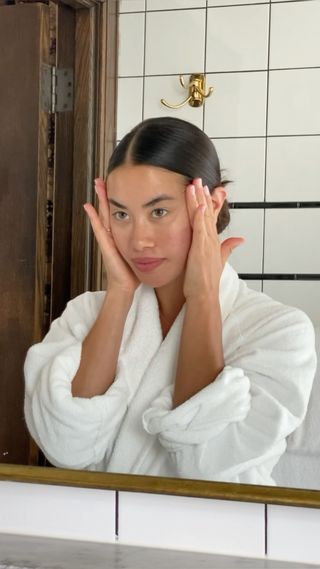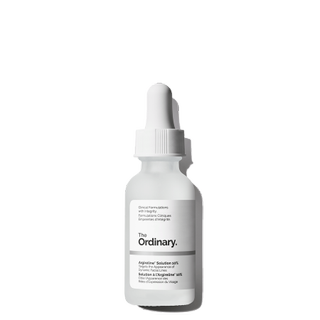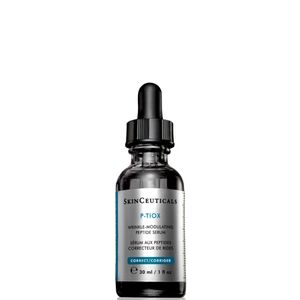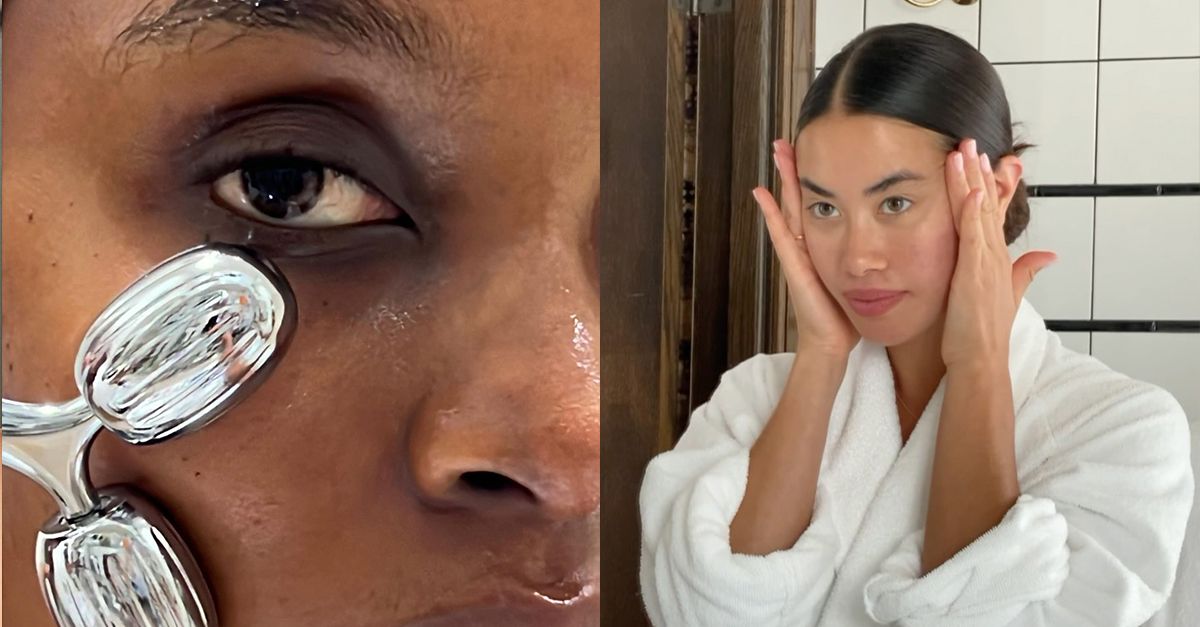In the world of beauty, it’s rare you find a treatment that remains as popular (and polarising) as Botox has—even over thirty years after it was first approved for cosmetic use. Renowned for its ability to seemingly reverse the key signs of skin ageing such as loose skin, fine lines, and wrinkles, Botox offers an immediate (and relatively painless) solution to the goals we’re all attempting to achieve with our “tweakment” products and buzzy sculpting tools.
Naturally, as a beauty editor, I’m no stranger to Botox myself. All in the name of research, I’ve had several treatments over the years to target my crow’s feet and a particularly deep forehead line. The results are almost instant, impressive, and long-lasting—I’d 100% do it again. But with that said, I totally understand that Botox isn’t for everyone. Whether it’s a fear of needles, the cost, or the upkeep putting you off, there are plenty of valid reasons why you might consider looking for an alternative to Botox instead.

Indeed, my interest is always piqued when Botox alternatives are mentioned. There are so many exciting innovations in skincare technology at the moment, that it is easy to envisage a future where people are able to achieve the same results, without the pain, expense, or downtime.
Right now, there are already a number of especially compelling treatments out there which dermatologists and cosmetic doctors are recommending to their clients as alternatives to Botox. From radio frequency microneedling to Sofwave and polynucleotides, keep scrolling for the four treatments I’m seriously considering opting for instead of my next Botox top-up.
But firstly, and in order for you to make a fair and informed comparison, I spoke to cosmetic doctor Rasha Rakhshani-Moghadam for the lowdown on exactly what Botox is.
What is Botox?
Most people have heard of Botox (the better known brand name for toxin)—you may even have had it yourself—but not everyone knows much about the science behind the treatment. “Toxin is an injectable cosmetic procedure that supports with anti-ageing,” says Rakhshani-Moghadam. “It has been the go-to treatment for many years, in helping to diminish fine lines and deeper wrinkles around the forehead, eyes and mouth. It works by blocking nerve signals that control facial muscles (in the target area only), therefore stopping any movement, releasing tension and ridding signs of ageing.”
What are the benefits of Botox?
According to Rakhshani-Moghadam, Botox provides several skin benefits. “Not only can it diminish fine lines and creases, it smooths and also prevents new wrinkles when maintained,” she explains. Aside from anti-ageing, toxin has many health benefits due to its muscle relaxing properties, helping to treat medical conditions like migraines, teeth grinding (when treating masseter muscle), and can even stop excessive sweating and muscle spasms.
What are the side effects of Botox?
“Toxin is generally a safe treatment, however downtime is dependent on each patient—some may be left with small bumps and bruises from the injection site, which relieve on their own, and some with none at all,” explains Rakhshani-Moghadam. “Some may also notice drooping eyebrows if toxin has been placed too close or has spread.”
Like any cosmetic procedure, it’s crucial that Botox is carried out by a trusted and licensed practitioner who will provide a consultation to understand your goals and lifestyle factors beforehand. “The treatment itself is not painful, however numbing cream can be provided for patient comfort,” she adds.
How long does Botox last?
According to Rakhshani-Moghadam, this is totally dependent on the patient, their lifestyle factors, and their history of Botox treatments, but generally speaking, results last for three to four months. “After then, they will require top ups to maintain the muscle relaxing and antiaging benefits,” she adds. “With regular and more consistent treatments, results can last longer.”
Alternatives to Botox:
1. Radio Frequency Microneedling
What is radio frequency microneedling?
Also known as Secret RF, this Botox alternative combines the benefits of two well-known anti-ageing treatments— radio frequency and microneedling. “A device delivers radiofrequency energy into varying levels of the skin, precisely to where treatment is most beneficial to the individual patient,” explains aesthetic doctor, Tapan Patel. “This unique delivery of energy helps revitalise and regenerate the tissue without causing much trauma to the epidermis as the skin is triggered into increasing its natural ability to produce collagen and elastin.”
According to Patel, this is a great option for those who want to look and feel tighter, smoother, lifted, and brighter. “It’s an incredible alternative to Botox, as the skin and skin quality as a whole is treated, rather than isolated areas.”
What are the benefits of radio frequency microneedling?
“As we age the quality of our skin diminishes,” explains Patel. “It becomes duller and loses its elasticity, and sun exposure causes discoloration and pigmentary issues. In addition to this, the natural breakdown of collagen causes the skin to sag, and wrinkles begin to form – which is often where Botox is brought in.”
Radio frequency microneedling offers considerable improvements in skin texture and appearance overall, but has minimal-to-no downtime. “It targets the common signs of ageing, and provides a dramatic improvement in the appearance of fine lines, wrinkles, skin texture and discoloration, without the need to keep ‘topping up’ as with toxins,” he says.
An additional benefit—thanks to the technology used—is safety. “The device features a combination of non-insulated and insulated tips that are designed to distribute energy evenly throughout the entire needle,” adds Patel. “Alongside enhancing results, it also enhances patient safety across all skin types and ensures optimal outcomes.”
What are the side effects of radio frequency microneedling?
“Secret RF is truly much more comfortable and with less redness and swelling than other devices on the market,” says Patel. “But it is normal to expect mild redness or swelling immediately after the procedure, as we are technically causing a micro-injury to the skin.”
How does radio frequency microneedling compare to Botox?
“Whilst still technically using needles, it’s completely different in terms of approach and results. We are not targeting specific muscles here as with Botox, we are treating the skin as a whole with a regenerative approach,” explains Patel. “The skin will look tighter and lifted, and patients will also benefit from skin that has been kickstarted into collagen production mode—so with time results will get better, rather than wearing off as with Botox.”
In addition, radio frequency microneedling is a great alternative to Botox for those who prefer to stay away from injectables or don’t want to have to commit to the frequent maintenance.
2. Sofwave
What is Sofwave?
Cosmetic doctor Saleena Zimri has seen a huge rise in those seeking alternatives to more invasive treatments in the past few years. “Sofwave is by far one of the most popular,” she says. “Delivered as a parallel beam ultrasound device to promote collagen, Sofwave is an FDA-cleared treatment that provides skin tightening and a reduction in fine lines, wrinkles, and sagging skin.”
What are the benefits of Sofwave?
According to Zimri, Sofwave is extremely popular with celebrities due to its benefits (tighter skin and reduced signs of skin ageing), its session lengths (30-60 min per session), and minimal downtimes. “You can go back to work and apply make up straight away if needed,” she adds. “And there is no risk to fat loss unlike other ultrasound based systems.”
What are the side effects of Sofwave?
“Some patients may feel tinging or an uncomfortable sensation whilst having the treatment, however numbing cream is used to ensure maximum patient comfort,” she explains. “Some may have mild redness, tenderness, or swelling to the targeted areas which resolves within hours, and some may have none at all.”
How does Sofwave compare to Botox?
While Sofwave itself is a totally different type of treatment to Botox, it can achieve similar outcomes. “Sofwave helps to encourage and promote collagen production, which can be lost over time with ageing,” explains Zimri. “This can result in firmer and more bouncier skin, whilst toxin temporarily stops facial muscles from moving, resulting in the reduction in wrinkles and movement as a whole.”
Another benefit? Sofwave can target a wider range of areas and concerns than Botox. “Sofwave is suitable for those seeking collagen support and solutions to laxity and a sculpted jawline or eye area, and can be used across several areas including submental, eyebrow, and neck,” Zimri adds. “Whilst toxin is great for those wanting to smooth out those finer lines and wrinkles from ageing and skin texture, and can be used across frown lines and crows feet—fully focusing on fine lines.”
But perhaps the most appealing perk of Sofwave is how long the results last for. “Sofwave has been proven to last typically up to a year to 18 months, whilst toxin requires regular maintenance every three to four months,” says Zimri. “This is great for those seeking a lower maintenance alternative.”
3. Polynucleotides
What are polynucleotides?
If you’ve seen buzz on social media about ‘salmon sperm’ treatments, polynucleotides is the official name for what’s being referred to. The treatment involves the injection of DNA fragments derived from fish—typically salmon and sometimes trout—into the skin to promote tissue regeneration and repair. “It is a minimally invasive procedure that aims to improve skin elasticity, hydration, and texture by stimulating collagen production and reducing inflammation,” explains dermatologist Hiba Injibar.
“Individuals seeking a more natural approach to skin rejuvenation, with a focus on long-term improvements in skin health and texture, might prefer polynucleotide treatments over Botox,” she adds. “It is also a good option for those looking to enhance skin hydration and elasticity without altering facial expressions, as Botox may sometimes do.”
What are the benefits of polynucleotides?
According to Injibar, polynucleotide treatments offer multiple benefits, including enhanced skin hydration, improved elasticity, and a reduction in fine lines and wrinkles. “By stimulating collagen production and promoting cell regeneration, it helps to restore a youthful appearance and improve skin texture,” she explains. “Additionally, it can help reduce inflammation, making it beneficial for treating skin conditions such as acne scars and pigmentation.”
What are the side effects of polynucleotides?
Compared to other treatments, a polynucleotides treatment is relatively quick, painless, and has minimal side effects. “Redness, swelling, or bruising at the injection site can occur,” says Injibar. “But these effects are typically temporary and resolve within a few days.”
How do polynucleotides compare to Botox?
“Unlike Botox, which temporarily relaxes facial muscles to reduce wrinkles, polynucleotide treatments focus on skin regeneration by improving hydration, elasticity, and collagen production,” explains Injibar. “While Botox offers quicker, more immediate wrinkle reduction, polynucleotides provide long-term skin health benefits by addressing overall skin quality and texture.”
“Polynucleotide treatments provide gradual, natural-looking improvements in skin texture and elasticity, with results becoming more noticeable over time,” she adds. “In contrast, Botox delivers faster, more dramatic wrinkle reduction, but its effects are temporary and focused on specific areas rather than overall skin rejuvenation.”
4. Hexapeptide-8
What is hexapeptide-8?
Looking for a completely non-invasive treatment that you can incorporate into your daily skincare routine? Look out for the ingredient acetyl hexapeptide-8. “It’s an exciting synthetic peptide that has been designed to work in a similar way to Botox,” explains consultant dermatologist Derrick Phillips.
Peptides are short chains of amino acids that serve as building blocks for proteins in the skin, playing a crucial role in maintaining skin structure and function,” he adds. “Acetyl hexapeptide 8 is a synthetic molecule made up of six peptides and has been designed to mimic the action of Botox. It works by preventing the release of neurotransmitters that are responsible for the contraction of the muscles of facial expression, relaxing the skin and improving the appearance of fine lines and wrinkles.”
What are the benefits of hexapeptide-8?
“Studies in female volunteers revealed a 30% reduction in wrinkle depth after just 30 days of application. Plus, it’s a great option for reducing the appearance of fine lines and wrinkles for those who are not fond of needles, and it can also be used to enhance the effects of Botox treatment,” says Phillips.
In fact, hexapeptide-8 can be easily incorporated into your morning and evening routine after cleansing and before applying your moisturiser or night cream. “Two products on the market that currently contain the Hexapeptide-8, are The Ordinary 10% Argireline Solution and SkinCeuticals P-TIOX,” adds Phillips. “Although I am sure there will be more to follow.”
What are the side effects of hexapeptide-8?
“Hexapeptide-8 is suitable for all skin types,” explains Phillips. “However, like Botox, it should not be used in people with neurological conditions like myasthenia gravis. If there are any concerns, consult a dermatologist before using the product.”
How does hexapeptide-8 compare to Botox?
“Acetyl hexapeptide-8 can be a non-invasive alternative to Botox for reducing the appearance of fine lines and wrinkles through relaxation of facial muscles, however, it is less potent,” says Phillips. “While it can improve skin texture over time with consistent use, the effects are usually more subtle and take longer to appear compared to Botox.”
For significant and immediate results, he advises that Botox remains a more effective option, though hexapeptide-8 can be a complementary addition to your skincare routine and may enhance the effects of Botox.
Shop hexapeptide-8:

The Ordinary
Argireline Solution 10%
Thanks to The Ordinary, you can sample the benefits of hexapeptide-8 for less than a tenner. Just don’t expect to see results overnight—this one will require patience and consistency.

SkinCeuticals are renowned for their potent and efficacious formulas, so they’re a reliable brand to go to if you want to give hexapeptide-8 a try. What’s more, this serum contains a cocktail of other active ingredients, including 5% polyhydroxyacids to gently exfoliate, brighten, and smooth skin texture, and niacinamide to hydrate and even skin tone.

